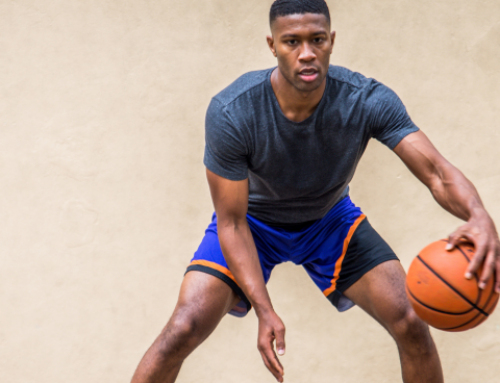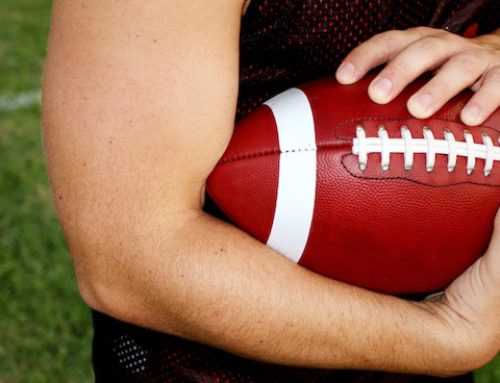Basketball Inbound Plays for Beginners
A basketball inbound play occurs at the beginning of every period, except for the first, after all made baskets and following any stoppages in play such as a dead-ball turnover (when the ball goes out of bounds), non-shooting foul, violation, inadvertent whistle, timeout or jump ball.
An inbound play will either take place on the baseline or sideline. The referee will take the ball to the location near the half-court line or to either side of the backboard where the play will begin. One player on the offensive team will step out of bounds behind the baseline or sideline and is given 5 seconds to pass the ball to a teammate.
At the beginning of the second, third and fourth quarters or the beginning of the second half in men’s college basketball, the ball will be taken out on the sideline near half court and possession will be determined by the direction of the possession arrow, depending on who received possession from the tip-off or last jump ball.
Basketball Inbound Play Location
After a made basket one of the five players now on the offensive team will take the ball out of bounds on the baseline. The inbound passer may run back and forth or even pass to a teammate who is also behind the baseline in order to throw it in.
Turnovers will cause the ball to be inbounded nearest the spot of the turnover or place at which the ball went out of bounds.
For non-shooting fouls and violations, the inbound spot will either be on the sideline or baseline depending on whether the foul or violation occurred inside or outside of the imaginary “Inbound Triangle” which runs from the corners of the baseline to the elbows of the free-throw line and includes the top of the key.
The diagram below shows the “Inbound Triangles” as the shaded regions on either side of the court.
The arrows within the triangle indicate that the ball will be spotted on the left or right side of the baseline, for the inbound play, depending on whether the foul or violation occurred on the left or right side of the court. The arrows outside of the triangle indicate which sideline the ball will be spotted depending on if the foul or violation occurred on the left or right side of the court.

Baseline
If the inbound location is on the baseline after a basket, the team that is now on offense will only need to run an inbound play if the defense is applying full-court pressure
In this situation the goal of an inbound play is to successfully pass the ball into a teammate in to begin breaking the press, or successfully advancing the ball, by dribbling or passing, through the full-court pressure and past half court.
If the inbound location is on the baseline under the defense’s basket, the offensive team is in a half-court setting and will employ an inbound play that uses cuts and screens to create an open shot.
Sideline
If the ball is taken out at a spot on the sideline that is on the side of half court opposite where a team is trying to score, inbound plays are usually designed to pass the ball into a ball handler who will then set up the offense.
If the ball is taken out in a spot on the sideline that is on the side of half court nearest to where a team is trying to score, it is common to see inbound plays designed to get the ball in to set up the offense or to use the inbound situation to run a designated play to create an open shot.
The diagram below represents the locations (marked with an X) at which the ball will be taken out for an inbound play due to a foul or violation.

Types of Basketball Inbound Plays
The two most common inbound sets are Stack and Box.

The Stack is often run from both the baseline and sideline out-of-bounds spots, and it is generally the most common sideline out-of-bounds set. From the baseline the stack can be used to create a jump shot, layup or to get the ball into a ball handler.
The basic stack begins with the four players who are inbounds standing in a straight line directly in front of the inbounder. These players will usually be almost touching each other. Player 1 will be the first in line standing in front of the ball; Player 4 who will be the last player in the line.
If the ball is on the baseline, Player 1 will cut to the near side corner, and Player 2 will cut to the opposite corner. If the ball is being taken out on the sideline the first two players will just split left and right.
After this action it is common to see Player 3 turn and set a screen for Player 4 before releasing back into the open court as a safety outlet. Player 4 will then run off the screen, cutting to the basket to catch a pass from the inbounder for a layup. If the play is being run on the sideline, Player 4 will then just cut to open space to secure the pass and begin the offense.
Stack Variation 1
Player 1 curls behind the stack into space for a safety outlet while Players 2 and 3 split opening space for Player 4 to cut to the ball or basket.
Stack Variation 2
Players 1 and 2 split left and right while Player 3 uses the space to cut to the ball or basket while Player 4 releases for a safety outlet.

The box is most commonly used as a baseline out-of-bounds set to create an open shot or scoring option. In a standard box set the four players who are inbounds will stand on both blocks and both elbows. Teams can run many plays out of a box set, but there are three basic plays best used for beginners and youth.
Player 1 will be on the block directly in front of the ball, Player 2 on the elbow directly in front of the ball, Player 3 on the opposite elbow, and Player 4 on the opposite block.
Box 1
Sometimes referred to as “screen the screener,” this set will begin with Player 1 running to the ball-side elbow to set a back screen for Player 2 who will cut to the near corner. Player 4 will then run to the ball-side elbow and set a screen for player 1 who will use the screen to cut to the opposite block for a layup. After setting that screen, Player 4 will turn and cut to the basket for a second layup option. While all of this is going on, player 3 will release for a safety outlet.
The goal of the play is first to get Player 1 open for a layup and then find Player 4 slipping to the basket if Player 1 is not open. Should neither of those options be open the inbounder should pass the ball to either Player 2 or Player 3 to get the ball in and start the offense.
Box 2
Box 2 simply involves Players 1 and 4 turning to set back screens on Players 2 and 3 who are directly behind them. Players 2 and 3 will both use the screens to cut straight to the blocks in front of them for layups, while Players 1 and 4 will release for safety outlets after setting their screens.
The goal of the play is to get Player 2 and Player 3 open for layups, and should they not be open, get the ball to either Player 1 or Player 4 to begin the offense.
Box 3
Box 3 involves Player 1 and Player 4 turning to set cross screens on Player 2 and Player 3. This means that Player 1 will set a screen for Player 3, and Player 4 will set a screen for Player 2.
To avoid confusion and keep proper spacing, the coach or players should decide and designate which player will set his or her screen first while the other pauses for a moment. This will make sure neither the players setting or receiving the screens run into each other. Players 2 and 3 will use the screens to cut to the block that is opposite their starting position for a layup, while Players 1 and 4 release for a safety outlet.
The goal of this play is to get Player 2 or 3 open for a layup, and should they not be open, get the ball to either Player 1 or 4 to begin the offense.
Types of Basketball Inbound Passes
The inbounder during an out-of-bounds play can use a bounce pass, chest pass or overhead pass to get the ball inbounds. Teams typically use a bounce pass for sideline or baseline out-of-bounds plays when passing to a player cutting to the ball or to the basket for a layup. The bounce pass is most effective to avoid the inbounder’s defender who will be protecting the basket or defending the the space in front of the sideline and get the ball to their teammate.
Use an overhead pass or high chest pass when making a longer pass over multiple players on the court to a teammate who is serving as a safety outlet in order get the ball in successfully and avoid a steal or deflection.
Finally, a chest pass can be used in any situation to get the ball in quickly to an open teammate anywhere on the court.
Basketball Inbounds Play Drills
The best way to practice inbounds plays and get your team to run them successfully is first to make sure your players know how to set a solid, legal screen. This will involve them standing with their feet set and hands placed properly to protect themselves and not turn the ball over due to an illegal screen.
Once your players know how to set a screen you should have your team practice running the plays without any defense so they memorize the movements and get the timing right to execute the goal of the play.
The final step is to have your team practice the plays against live defense so they become better at setting screens, getting open and using the plays to score in different ways.
Common Basketball Inbound Play Defenses and How to Beat Them
Man to Man:
The best way to run a successful inbounds play against a man-to-man defense s to execute the play with hard cuts and good screens. This will give your team the best chance to score by creating situations that will force the defense to communicate and switch, hedge or trap and make it difficult for the defense to prevent open looks.
Zone:
Against a zone defense, hard cuts and good screens are also very important to get an offensive player into open space. But it is also important for the offensive team to recognize that against a zone the normal cuts and screens that can be run against man-to-man defense may have to be altered against a zone. To beat the zone, the offense needs to recognize and exploit the gaps and spaces in the zone to get open looks.
READ MORE:
- Developing an Offensive Philosophy for Basketball
- 4 Youth Basketball Drills That Teach the Fundamentals
- Elements of a Winning Basketball Playbook
RECOMMENDED FOR YOU
Basketball Inbound Plays for Beginners
A basketball inbound play occurs at the beginning of every period, except for the first, after all made baskets and following any stoppages in play such as a dead-ball turnover (when the ball goes out of bounds), non-shooting foul, violation, inadvertent whistle, timeout or jump ball.
An inbound play will either take place on the baseline or sideline. The referee will take the ball to the location near the half-court line or to either side of the backboard where the play will begin. One player on the offensive team will step out of bounds behind the baseline or sideline and is given 5 seconds to pass the ball to a teammate.
At the beginning of the second, third and fourth quarters or the beginning of the second half in men’s college basketball, the ball will be taken out on the sideline near half court and possession will be determined by the direction of the possession arrow, depending on who received possession from the tip-off or last jump ball.
Basketball Inbound Play Location
After a made basket one of the five players now on the offensive team will take the ball out of bounds on the baseline. The inbound passer may run back and forth or even pass to a teammate who is also behind the baseline in order to throw it in.
Turnovers will cause the ball to be inbounded nearest the spot of the turnover or place at which the ball went out of bounds.
For non-shooting fouls and violations, the inbound spot will either be on the sideline or baseline depending on whether the foul or violation occurred inside or outside of the imaginary “Inbound Triangle” which runs from the corners of the baseline to the elbows of the free-throw line and includes the top of the key.
The diagram below shows the “Inbound Triangles” as the shaded regions on either side of the court.
The arrows within the triangle indicate that the ball will be spotted on the left or right side of the baseline, for the inbound play, depending on whether the foul or violation occurred on the left or right side of the court. The arrows outside of the triangle indicate which sideline the ball will be spotted depending on if the foul or violation occurred on the left or right side of the court.

Baseline
If the inbound location is on the baseline after a basket, the team that is now on offense will only need to run an inbound play if the defense is applying full-court pressure
In this situation the goal of an inbound play is to successfully pass the ball into a teammate in to begin breaking the press, or successfully advancing the ball, by dribbling or passing, through the full-court pressure and past half court.
If the inbound location is on the baseline under the defense’s basket, the offensive team is in a half-court setting and will employ an inbound play that uses cuts and screens to create an open shot.
Sideline
If the ball is taken out at a spot on the sideline that is on the side of half court opposite where a team is trying to score, inbound plays are usually designed to pass the ball into a ball handler who will then set up the offense.
If the ball is taken out in a spot on the sideline that is on the side of half court nearest to where a team is trying to score, it is common to see inbound plays designed to get the ball in to set up the offense or to use the inbound situation to run a designated play to create an open shot.
The diagram below represents the locations (marked with an X) at which the ball will be taken out for an inbound play due to a foul or violation.

Types of Basketball Inbound Plays
The two most common inbound sets are Stack and Box.

The Stack is often run from both the baseline and sideline out-of-bounds spots, and it is generally the most common sideline out-of-bounds set. From the baseline the stack can be used to create a jump shot, layup or to get the ball into a ball handler.
The basic stack begins with the four players who are inbounds standing in a straight line directly in front of the inbounder. These players will usually be almost touching each other. Player 1 will be the first in line standing in front of the ball; Player 4 who will be the last player in the line.
If the ball is on the baseline, Player 1 will cut to the near side corner, and Player 2 will cut to the opposite corner. If the ball is being taken out on the sideline the first two players will just split left and right.
After this action it is common to see Player 3 turn and set a screen for Player 4 before releasing back into the open court as a safety outlet. Player 4 will then run off the screen, cutting to the basket to catch a pass from the inbounder for a layup. If the play is being run on the sideline, Player 4 will then just cut to open space to secure the pass and begin the offense.
Stack Variation 1
Player 1 curls behind the stack into space for a safety outlet while Players 2 and 3 split opening space for Player 4 to cut to the ball or basket.
Stack Variation 2
Players 1 and 2 split left and right while Player 3 uses the space to cut to the ball or basket while Player 4 releases for a safety outlet.

The box is most commonly used as a baseline out-of-bounds set to create an open shot or scoring option. In a standard box set the four players who are inbounds will stand on both blocks and both elbows. Teams can run many plays out of a box set, but there are three basic plays best used for beginners and youth.
Player 1 will be on the block directly in front of the ball, Player 2 on the elbow directly in front of the ball, Player 3 on the opposite elbow, and Player 4 on the opposite block.
Box 1
Sometimes referred to as “screen the screener,” this set will begin with Player 1 running to the ball-side elbow to set a back screen for Player 2 who will cut to the near corner. Player 4 will then run to the ball-side elbow and set a screen for player 1 who will use the screen to cut to the opposite block for a layup. After setting that screen, Player 4 will turn and cut to the basket for a second layup option. While all of this is going on, player 3 will release for a safety outlet.
The goal of the play is first to get Player 1 open for a layup and then find Player 4 slipping to the basket if Player 1 is not open. Should neither of those options be open the inbounder should pass the ball to either Player 2 or Player 3 to get the ball in and start the offense.
Box 2
Box 2 simply involves Players 1 and 4 turning to set back screens on Players 2 and 3 who are directly behind them. Players 2 and 3 will both use the screens to cut straight to the blocks in front of them for layups, while Players 1 and 4 will release for safety outlets after setting their screens.
The goal of the play is to get Player 2 and Player 3 open for layups, and should they not be open, get the ball to either Player 1 or Player 4 to begin the offense.
Box 3
Box 3 involves Player 1 and Player 4 turning to set cross screens on Player 2 and Player 3. This means that Player 1 will set a screen for Player 3, and Player 4 will set a screen for Player 2.
To avoid confusion and keep proper spacing, the coach or players should decide and designate which player will set his or her screen first while the other pauses for a moment. This will make sure neither the players setting or receiving the screens run into each other. Players 2 and 3 will use the screens to cut to the block that is opposite their starting position for a layup, while Players 1 and 4 release for a safety outlet.
The goal of this play is to get Player 2 or 3 open for a layup, and should they not be open, get the ball to either Player 1 or 4 to begin the offense.
Types of Basketball Inbound Passes
The inbounder during an out-of-bounds play can use a bounce pass, chest pass or overhead pass to get the ball inbounds. Teams typically use a bounce pass for sideline or baseline out-of-bounds plays when passing to a player cutting to the ball or to the basket for a layup. The bounce pass is most effective to avoid the inbounder’s defender who will be protecting the basket or defending the the space in front of the sideline and get the ball to their teammate.
Use an overhead pass or high chest pass when making a longer pass over multiple players on the court to a teammate who is serving as a safety outlet in order get the ball in successfully and avoid a steal or deflection.
Finally, a chest pass can be used in any situation to get the ball in quickly to an open teammate anywhere on the court.
Basketball Inbounds Play Drills
The best way to practice inbounds plays and get your team to run them successfully is first to make sure your players know how to set a solid, legal screen. This will involve them standing with their feet set and hands placed properly to protect themselves and not turn the ball over due to an illegal screen.
Once your players know how to set a screen you should have your team practice running the plays without any defense so they memorize the movements and get the timing right to execute the goal of the play.
The final step is to have your team practice the plays against live defense so they become better at setting screens, getting open and using the plays to score in different ways.
Common Basketball Inbound Play Defenses and How to Beat Them
Man to Man:
The best way to run a successful inbounds play against a man-to-man defense s to execute the play with hard cuts and good screens. This will give your team the best chance to score by creating situations that will force the defense to communicate and switch, hedge or trap and make it difficult for the defense to prevent open looks.
Zone:
Against a zone defense, hard cuts and good screens are also very important to get an offensive player into open space. But it is also important for the offensive team to recognize that against a zone the normal cuts and screens that can be run against man-to-man defense may have to be altered against a zone. To beat the zone, the offense needs to recognize and exploit the gaps and spaces in the zone to get open looks.
READ MORE:
- Developing an Offensive Philosophy for Basketball
- 4 Youth Basketball Drills That Teach the Fundamentals
- Elements of a Winning Basketball Playbook










